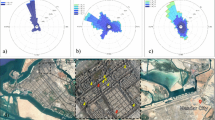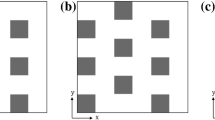Abstract
The constant building drag coefficient was replaced by a mechanical drag coefficient formulation in a multilayer urban canopy system coupled with the Rapid-refresh Multiscale Analysis and Prediction System to improve the wind speed prediction performance in complex urban areas. Although this formulation has been assessed in idealized urban areas by computational fluid dynamic simulations, the applicability of this formulation has not been sufficiently evaluated, especially in complex urban areas with inhomogeneously distributed tall buildings. The main objective of this study is to evaluate the performance of the coupled system in the Beijing urban area. The results show that the average wind speed model performance is improved by 40% in summer and 36% in winter by introducing a drag coefficient into the regional forecast model.






Similar content being viewed by others
References
Ashie Y, Vu Thanh C, Asaeda T (1999) Building canopy model for the analysis of urban climate. J Wind Eng Ind Aerodyn 81:237–248
Bornstein RD (1987) ‘Mean diurnal circulation and thermodynamic evolution of urban boundary layers’, in modelling the urban boundary layer. American Meteorological Society, Boston, pp 53–94
Bougeault P, Lacarrere P (1989) Parameterization of orography induced turbulence in a mesobeta-scale model. Mon Weather Rev 117:1872–1890
Burian S, Augustus N, Jeyachandran I, Brown M (2008) National building statistics database: version 2. Technical Report. Los Alamos National Laboratory, New Mexico, 18 pp
Carvalho D, Rocha A, Gómez-Gesteira M, Santos C (2012) A sensitivity study of the WRF model in wind simulation for an area of high wind energy. Environ Model Softw 33:23–34
Ching J, Brown M, Burian S, Chen F, Cionco R, Hanna A, Hultgren T, McPherson T, Sailor D, Taha H, Williams D (2009) National Urban Database and Access Portal Tool (NUDAPT). Bull Am Meteorol Soc 90(08):1157–1168
Coceal O, Belcher SE (2004) A canopy model of mean winds through urban areas. Quart J Roy Meteorol Soc 130:1349–1372. https://doi.org/10.1256/qj.03.40
Dudhia J (1989) Numerical study of convection observed during the winter monsoon experiment using a mesoscale two-dimensional model. J Atmos Sci 46:3077–3107
Fan S (2015) Assessment report of regional high resolution model (BJ-RUCv3.0). IUM technical note IUM/2015-1. IUM: Beijing, China
Grell GA, Dudhia J, Stauffer DR (1994) A description of the fifth generation PSU/NCAR mesoscale modeling system (MM5). Technical Note NCAR/TNd379 þ STR, NCAR
Gutiérrez E, Martilli A, Santiago JL, González JE (2015) A mechanical drag coefficient formulation and urban canopy parameter assimilation technique for complex urban environments. Bound-Layer Meteorol 157(2):333–341
He X, Li Y, Wang X, Chen L, Yu B, Zhang Y et al (2019) High-resolution dataset of urban canopy parameters for Beijing and its application to the integrated wrf/urban modelling system. J Clean Prod 208:373–383
Hosker R (1984) Flow and diffusion near obstacles in atmospheric science and power production, Ch. 7, DOE/TIC-27601
Kusaka H, Kondo H, Kikegawa Y, Kimura F (2001) A simple single-layer urban canopy model for atmospheric models: comparison with multi-layer and slab models. Bound-Layer Meteorol 101:329–358
Liu Y, Chen F, Warner T, Basara J (2006) Verification of a mesoscale data-assimilation and forecasting system for the Oklahoma City area during the joint urban 2003 field project. J Appl Meteorol Climatol 45:912–929. https://doi.org/10.1175/JAM2383.1
Martilli A, Clappier A, Rotach MW (2002) An urban surface exchange parameterization for mesoscale models. Bound-Layer Meteorol 104:261–304. https://doi.org/10.1023/A:1016099921195
Masson V (2000) A physically-based scheme for the urban energy budget in atmospheric models. Bound-Layer Meteorol 94:357–397
Mlawer E, Taubman S, Brown P, Iacono M, Clough S (1997) Radiative transfer for inhomogeneous atmosphere:RRTM, a validated correlated-k model for longwave. J Geophys Res 102(D14):16663–16682
Monin AS, Obukhov AM (1954) Basic laws of turbulent mixing in the surface layer of the atmosphere. Tr Akad Nauk SSSR Geophiz Inst 24(151):163–187
Pryor SC, Nikulin G, Jones C (2012) Influence of spatial resolution on regional climate model derived wind climates. J Geophys Res Atmos 117(D3). https://doi.org/10.1029/2011JD016822
Raupach MR (1992) Drag and drag partition on rough surfaces. Bound-Layer Meteorol 60:375–395
Salamanca F, Krpo A, Martilli A, Clappier A (2009) A new building energy model coupled with an urban canopy parameterization for urban climate simulations- Part1 formulation, verification and sensitivity analysis of the model. Theor Appl Clim 99(3–4):331–344. https://doi.org/10.1007/s00704-009-0142-9
Santiago JL, Martilli A (2010) A dynamic urban canopy parameterization for mesoscale models based on computational fluid dynamics Reynolds-averaged Navier–stokes microscale simulations. Bound Layer Meteorol 137:417–439
Skamarock WC, Klemp JB, Dudhia J, Gill DO, Barker D, Wang W, Powers JG (2008) A description of the advanced research WRF version 3, NCAR/TN-475 + STR
Thompson G, Rasmussen R, Manning K (2004) Explicit forecasts of winter precipitation using an improved bulk microphysics scheme. Part I: description & sensitivity analysis. Mon Weather Rev 132:519–542. https://doi.org/10.1175/2008MWR2387.1
Uno I, Ueda H, Wakamatsu S (1989) Numerical modelling of the nocturnal urban boundary layer. Bound Layer Meteorol 49:77–98
Zhang D-L, Zheng W (2004) Diurnal cycles of surface winds and temperatures as simulated by five boundary-layer parameterizations. J Appl Meteorol 43:157–169. https://doi.org/10.1175/1520-0450(2004)043<0157:DCOSWA>2.0.CO;2
Zhang Y, Miao S, Dai Y, Liu YH (2013) Numerical simulation of characteristics of summer clear day boundary layer in Beijing and the impact of urban underlying surface on sea breeze [in Chinese]. Chin J Geophys 56(8):2558–2573
Author information
Authors and Affiliations
Corresponding author
Additional information
Publisher’s note
Springer Nature remains neutral with regard to jurisdictional claims in published maps and institutional affiliations.
Rights and permissions
About this article
Cite this article
Yu, M., González, J. & Miao, S. Evaluation of a mechanical drag coefficient formulation in the complex urban area of Beijing. Theor Appl Climatol 142, 743–749 (2020). https://doi.org/10.1007/s00704-020-03354-6
Received:
Accepted:
Published:
Issue Date:
DOI: https://doi.org/10.1007/s00704-020-03354-6




